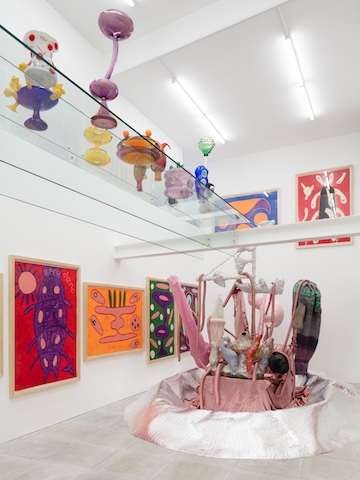The 15 mixed-media-on-paper works lining the left and right walls of The Sunday Painter’s narrow groundfloor gallery present a variety of scenarios: a blue amoeba with three nuclei shedding electric-orange bolts; a multichambered structure crouched over a roadway; large, labia-shaped vessels being urinated into. Further down, the images begin to resolve into a coherent set: the view out a car window at a line of towering, fanciful roadside lanterns, labelled on the drawing itself as ‘Seven Lanterns of Sin Southbo’. Another view from a car (the interior of the automobile visible around the edges of the drawing), this one of colourful misshapen fingers that become identifiable in subsequent drawings as architectonic structures with eyelike windows, labelled ‘Seven Towers of Virtue Northbo’. In a work titled The Seven Lanterns of Sin and The Seven Towers of Virtue in the rear view mirror (1998) we see that these two structural agglomerations face each other across a motorway. A map of Great Britain with a fluorescent-orange ring road around London and key routes to the regions, the word ‘Virtue’ overlaid on the Irish Sea and ‘Sins’ on the North Sea, drives home, so to speak, the notion of motorway network as organising principle for life, with service stations offering guidance, indulgence and a place to relieve oneself along the way. In entering this confined space, gallery visitors, looking left and right at these roadside scenes, are reminded that we too are on this motorway.
Nicholas Pope, now seventy, and showing at The Sunday Painter for the first time, found early success as a sculptor (he represented Britain at the Venice Biennale in 1980) and then withdrew, following a period of illness. He returned during the 1990s with a series of works that circled around, without settling on, matters of faith, including the installation The Apostles Speaking in Tongues Lit by Their Own Lamps (1993–96), whose three-metre-tall terracotta figures were shown at Tate Britain in 1996–97, and The Ten Commandments in Flowing Light (1996–97), a profusion of pastel-coloured stuffed-cloth shapes erupting from a six-metre-diameter foil crater. Sins and Virtues is thematically and materially of a piece with those works as the exhibition expands into the gallery’s lower-ground space with a more recent body of work. Here a series of 14 largescale, brightly coloured oil bar works crowd the walls, as 14 coloured-glass vessels perch delicately on a clear shelf running overhead, each representing one of the vices or virtues (The Conundrum of the Chalices of the Seven Deadly Sins and Seven Virtues, 2014). There is an approximate correlation between drawing and chalice, and one can puzzle out, from scrambled letters included in the pieces, which represents Lust, which Prudence, Gluttony and so on. But it’s a reminder that the Seven Deadly Sins and the Seven Virtues do not themselves directly correlate, and that although virtues are perhaps intended to serve in an advisory role while we negotiate the sins, one does not cancel out the other. This is the middle space the artist seems to be working with as the exhibition builds towards its culmination: a profusion of cloth and ceramic exploding from a sculptural foil crater (Sofa of the Deadly Sins and Coffee Table of Virtue, 1998–2018). Flesh-coloured tentacles and tubes, sea worms and further organlike shapes and creatures present a close-to-horrifying dredging up of the elemental and primordial. It’s a reminder that, regardless of direction of travel, this all ends in oblivion.
Nicholas Pope: Sins and Virtues at The Sunday Painter, London, 15 September – 24 November
From the January & February 2019 issue of ArtReview
